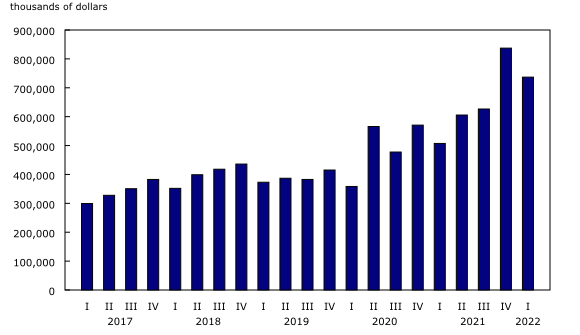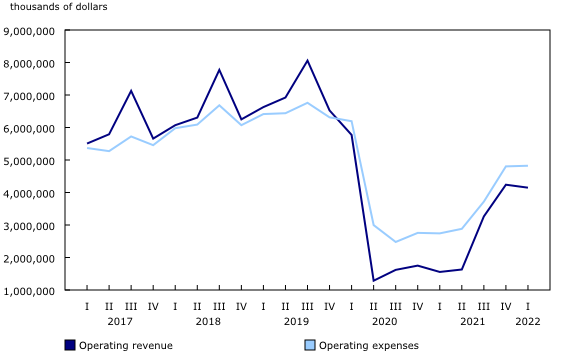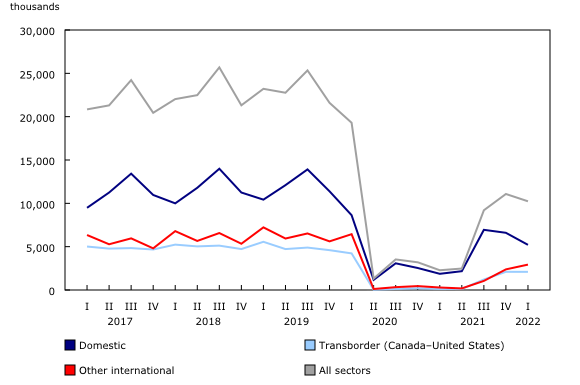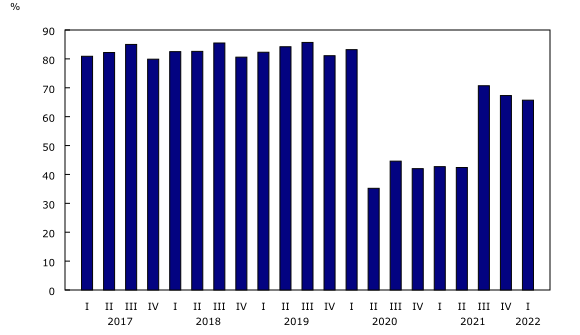Quarterly civil aviation statistics, first quarter 2022
Released: 2022-08-19
Highlights
Operating revenue for the 24 largest Canadian air carriers (Levels I and II) totalled $4.1 billion in the first quarter, well above the same quarter of 2021, but under two-thirds (62.6%) of that generated in the first quarter of 2019.
At $3.1 billion, passenger revenue remained the main revenue source for airlines, while air cargo generated $736.8 million, representing 17.8% of the total, higher than the 5% to 7% range in revenue contribution recorded pre-pandemic.
In the first quarter of 2022, Canadian carriers transported 10.2 million passengers on scheduled and charter services, down from the 11.1 million passengers carried in the previous quarter.
On March 11, 2020, COVID-19 was declared a pandemic by the World Health Organization. In the months that followed, Canadian air travel remained well below historical levels. Unless otherwise specified, comparisons are made with the same quarter in 2019 (also referred to as "pre-pandemic levels"), when airline activity levels were in line with historical trends.
Recovery in air travel stalls
During the first quarter of 2022, operating revenue for the 24 largest Canadian air carriers totalled $4.1 billion. Operating revenue was 62.6% of that generated in the first quarter of 2019, down from the 65.0% proportion of the revenue generated in the fourth quarter of 2021 (compared with the fourth quarter of 2019).
At $3.1 billion, passenger revenue accounted for three-quarters (75.0%) of the total operating revenue, much lower than the 89.8% proportion in the same quarter of 2019.
Cargo has continued to supplement operations for many airlines as goods revenue accounted for $736.8 million in the first quarter of 2022. With a seasonal drop from $837.2 million earned in the fourth quarter of 2021, revenues were almost double those generated in the same quarter of 2019 and represent 17.8% of total operating revenue.
On the other side of the ledger, total operating expenses were $4.8 billion, 24.8% below the first quarter of 2019. With available seat kilometres declining more than this, the airlines' operating cost per available seat-kilometre (scheduled services only) was 39.1% higher than the first quarter of 2019.
Compared with the same quarter of 2019, employment was 16.4% lower, while wages, salaries and benefits increased by 5.8%. Airlines incurred $1.2 billion in expenses for their 52,539 employees.
With higher energy prices, Canadian air carriers spent $1.2 billion on turbo fuel. While down 27.2% from the same quarter in 2019, the fuel cost per hour flown rose 35.3%. Indeed, the Industrial Product Price Index reported a sharp increase (+41.4%) in jet fuel for the January to March reference months of 2022 compared with the same months in 2019.
Other operating expenses, such as depreciation and maintenance, accounted for the largest share (50.1%) of total operating expenses in the first quarter, followed by wages, salaries and benefits (25.2%) and turbo fuel (24.7%).
The bottom line is that Canadian air carriers reported a ninth consecutive quarter of net operating loss. This loss of $674.2 million in the first quarter combined with a net non-operating loss of $234.1 million resulted in a total net loss of $908.4 million for the quarter.
International traffic continues to climb
The 24 largest Canadian air carriers transported 10.2 million passengers in the first quarter, 9.9 million on scheduled flights and 344,000 on chartered flights. While this was more than four times the number of passengers carried in the same quarter of 2021, it was less than half (44.1%) of the pre-pandemic level reported in the same quarter of 2019.
In the first quarter of 2022, the number of passengers on domestic routes was 5.2 million, while the international sector increased to 5.0 million. As travel restrictions were eased and the number of international routes increased in 2021, such passengers represented roughly half of the total in the first quarter of 2022, with 2.1 million flying transborder (flights between Canada and the United States) and 2.9 million flying other international. During this same period of 2021, passengers on international routes represented 17.8% of the total.
Scheduled (non-charter) traffic was 24.1 billion passenger-kilometres in the first quarter of 2022, while capacity was 36.7 billion available seat-kilometres resulting in a 65.7% load factor for the quarter. This was below the pre-pandemic level of 82.3% and the second consecutive quarterly decline.
Note to readers
This release covers Canadian Level I and II air carriers. Because of the impact of the COVID-19 pandemic, no air carrier level changes were applied for reference year 2022.
Level I air carriers include every Canadian air carrier that, in the calendar year before the year in which information is provided, transported at least 2 million revenue passengers or at least 400 000 tonnes of cargo.
Level II air carriers include every Canadian air carrier that, in the calendar year before the year in which information is provided, transported (a) at least 100,000, but fewer than 2 million, revenue passengers, or (b) at least 50 000 tonnes, but less than 400 000 tonnes, of cargo.
Net non-operating income and loss are from commercial ventures that are not part of the air transportation services, from other revenues and expenses attributable to financing or other activities that are not an integral part of air transportation, and from special recurrent items of a non-periodic nature. Provision for income taxes is also included. Non-operating income can be, for example, capital gains from the sale of aircraft, interest income and foreign exchange adjustment, while non-operating expenses can include capital losses and interest on bank loans and other debt.
Data in this release are not seasonally adjusted.
Data from the second quarter of 2020 to the fourth quarter of 2021 have been revised.
Because of rounding, components may not add up to the total.
Contact information
For more information, or to enquire about the concepts, methods or data quality of this release, contact us (toll-free 1-800-263-1136; 514-283-8300; infostats@statcan.gc.ca) or Media Relations (statcan.mediahotline-ligneinfomedias.statcan@statcan.gc.ca).
- Date modified:





